Where Can I View My Saved Passwords? [Browsers & Phones]
Apr 27, 2022 • Filed to: Password Solutions • Proven solutions
In the earlier days, we probably had less than five passwords (mostly emails) to remember. But as the internet spread across the world and with the emergence of social media, our lives started revolving around it. And today, we have passwords for various apps and websites that even we do not know about.

Undoubtedly, managing these passwords is challenging, and we all need assistance. Hence, every browser comes to help with its own manager, which many of us are unaware of. And if you are someone with a bad habit of writing the passwords down, this article will tell you why you should not do that as you already have the password managers.
Without further ado...
Let's go step by step and understand how our passwords are saved and view them.
Part 1: Where do we usually save passwords?
Nowadays, keeping track of the passwords you use on several online networks and portals is a general feature that most well-known web browsers possess. And many of you might not be aware that this feature is turned on by default, saving probably all of your passwords in the cloud and settings for your default browser.
And if you are someone who uses more than one browser, you need to be alert about it as you have your passwords randomly saved here and there.
So let's see where does your browser actually store passwords?
1.1 Save passwords on Internet explorer:
- Internet Explorer:
While visiting websites or apps that require your username and passwords, Internet Explorer supports remembering them. This password-saving feature can be turned on by going to the Internet Explorer browser and select the "Tools" button. Then click on "Internet options.
Now on the "Content" tab (below AutoComplete), select "Settings" followed by ticking the check box for whichever Usernames and password you want to save. Select "OK," and you are good to go.
- Google Chrome:
Google Chrome's built-in password manager is connected to the Google account you use to sign in using the browser.
So whenever you provide a new password to a site, Chrome will prompt you to save it. So to accept, you select the "Save" option.
Chrome provides you with an option to use the saved passwords across the devices. So in every instance when you sign in to Chrome, you can save that password to the Google account, and then you can use those passwords on all your devices and apps on Android phones.
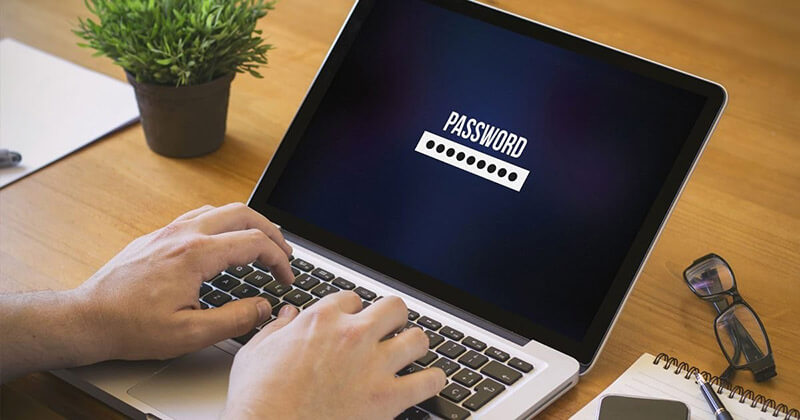
- Firefox:
Just like Chrome, your login credentials are stored in Firefox password manager and cookies. Your usernames and passwords are stored securely to access the websites with Firefox Password Manager, and it autofills them when you visit next time.
When you type your username and password on Firefox for the first time on any particular website, Firefox's Remember Password prompt will appear, asking you whether you want Firefox to remember the credentials. When you select the "Remember Password" option, Firefox will automatically log you into that website during your next visit.
- Opera:
Go to Opera browser on your computer and select the "Opera" menu. Select "Setting" from the menu and scroll down to the "Advanced Settings" option.
Here you need to look for the "Autofill" section and select the "Passwords" tab. Now enable the toggle to save "Offer to save passwords". This is where Opera will save your passwords every time you create a new account.
- Safari:
Similarly, if you are a MacOS user and browse using Safari, you will also be asked for your consent whether you want to save the password or not. If you select the "Save password" option, you will directly be logged into your account from there onwards.
1.2 Save passwords with mobile phone
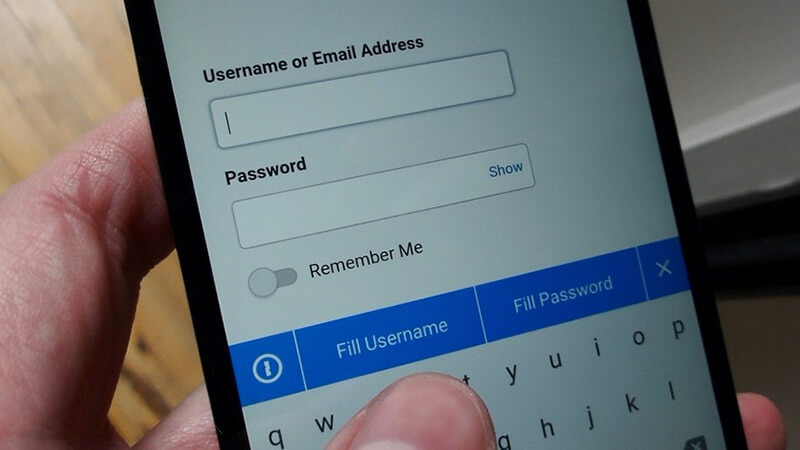
- iPhone:
If you are an iPhone user and use several social networking services such as Facebook, Gmail, Instagram, and Twitter, your phone allows you to configure the device and automatically fill in the username and password. To enable this feature, you need to go to the "Settings" and select "Passwords & Accounts". Next, click on the "Autofill" option and confirm that the slider is turned green.
You can use this feature while creating a new account, and your iPhone will store the password.
- Android:
If your Android device is linked with the Google account, your password manager will track all the passwords you use on Google Chrome.
Your passwords are stored on Chrome's cloud storage which lets you use your passwords even on your computer. Hence, you can access your passwords from any device logged in using your Google account.
Save passwords in other ways:
- Writing it down on a paper:

Many people choose the most convenient way to remember passwords by noting them down on paper. Although it sounds clever, you should refrain from doing that.
- Saving passwords on mobile phones:
Just like the above idea, this is another method that sounds tempting too. Many of you think what's the harm of saving the passwords in notes or documents on the device. But this method too is vulnerable as those documents on your cloud can be backed up easily by hackers.
- Same password for every account:
This is also one of the widely used methods that many of us use. To manage all the accounts, you think one single password would be easy. This can lead you to be an easy target by someone you know. They need to correctly guess one password and use password recovery to access all sensitive accounts and information.
Part 2: How to view saved passwords?
2.1 Check Internet explorer saved passwords
Chrome:
Step 1: Go to "Settings" in Chrome on your computer.
Step 2: Click on the "Passwords" option.
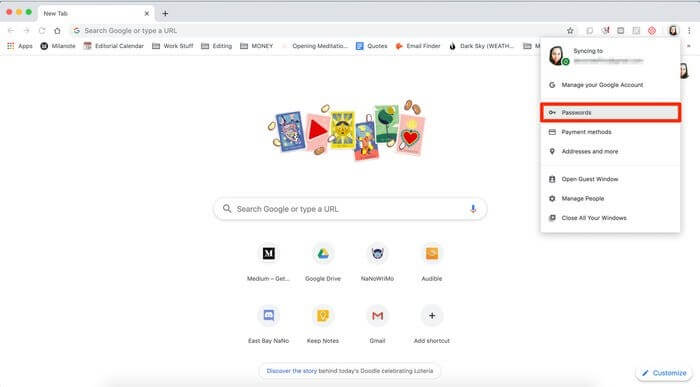
Step 3: Next, tap on the eye icon. Here you might be asked to verify your computer's password.
Step 4: After verification, you can view the password for whichever website you want to.
Firefox:
Step 1: To view where your passwords are saved in Firefox, go to the "Settings".
Step 2: Select the "Login and passwords" option provided under the "General" section.
Step 3: Next, select "Saved passwords," After entering your device password, click on any of the websites you want to view the password for.
Opera:
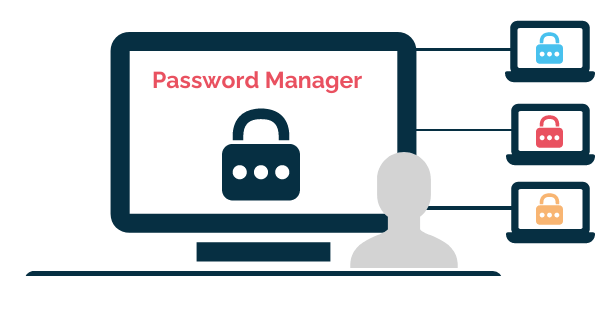
Step 1: Open Opera browser and select the Opera icon from the upper left corner.
Step 2: Select the "Settings" option to move ahead.
Step 3: Next, click on "Advanced" and select the "Privacy & Security" option.
Step 4: Now, in the "Autofill" section, select "Passwords".
Step 5: Click on the "eye icon," If prompted, provide your device password and select "OK" to view the password.
Safari:
Step 1: Open the Safari browser and select the "Preferences" option.
Step 2: Click on the "Passwords" option. You will be asked to provide your Mac password or use Touch ID for verification.
Step 3: Then, you can click on any website to view the stored password.
2.2 Check your saved passwords on your phone
iPhone:
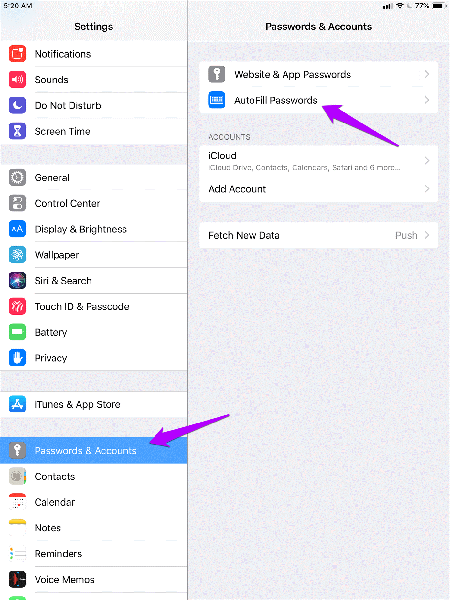
Step 1: Open "Settings" on your iPhone and then click on "Passwords". For iOS 13 or earlier, tap on "Passwords & Accounts", then click the "Website & App Passwords" option.
Step 2: Verify yourself with Face/ Touch ID when prompted, or type your passcode.
Step 3: Click on the website you want to view the password for.
Android:
Step 1: To see where the passwords are saved, go to the Chrome app on your device and click on three vertical dots on the top-right.
Step 2: Then select "Settings" followed by "Passwords" in the next menu.
Step 3: You will have to enter your device password for verification purposes, and then a list of all the websites will appear for which the passwords have been saved.
Part 3: View saved passwords with password saver app
For iOS:
Most of you have almost dozens of online accounts which require strong security with unique passwords. Creating those passwords is a task, and then remembering them is difficult too. And although Apple's iCloud Keychain provides a reliable service to store and sync your passwords, it should not be the only way to recover them.
Hence let me introduce you to Dr.Fone - Password Manager (iOS), a password manager that stores all the vital login credentials safe and secure. It can also help you with:
- Easily recover stored websites & app login passwords.
- Retrieve your saved Wi-Fi passwords
- Dr.Fone helps you find your Apple ID account and passwords.
- After Scan, views your mail.
- Then you need to recover the app login password and stored websites.
- After this, find the saved WiFi passwords.
- Recover passcodes of screen time
Below is how you can recover your password using it.
Step 1: You will have to download the Dr.Fone app on your iPhone/iPad and then look for the "Password Manager option and click on it.
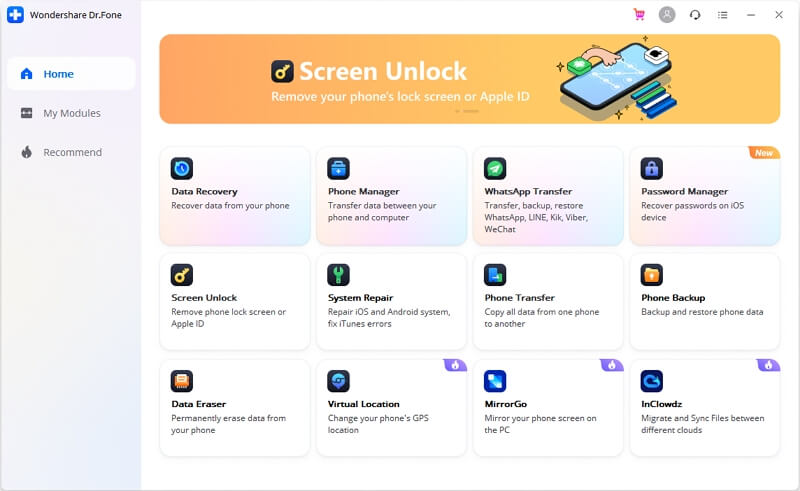
Step 2: Next, connect your iOS device with your laptop/PC using the lightning cable. Once connected, your screen will show a "Trust This Computer" alert. To proceed ahead, select the "Trust" option.
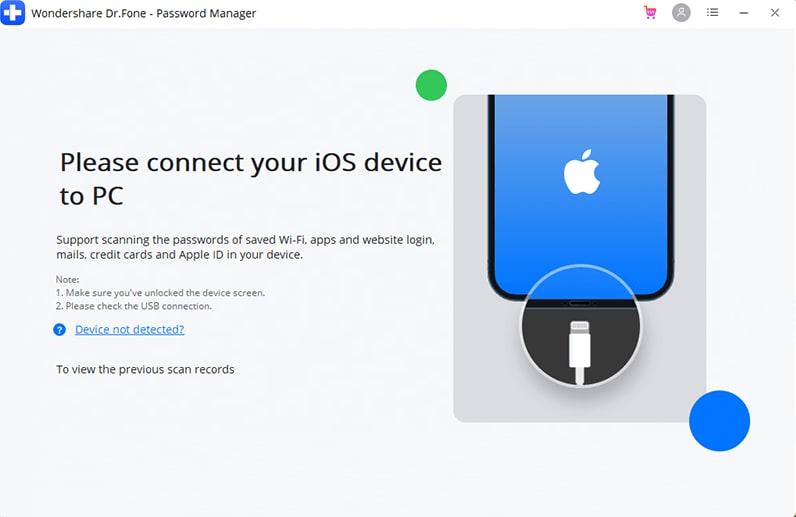
Step 3: You will have to resume the scanning process by tapping on "Start Scan".

Now sit back and relax until Dr.Fone does its part, which might take few moments.
Step 4: Once the scanning process finishes using Dr.Fone - Password Manager, you can retrieve your passwords.
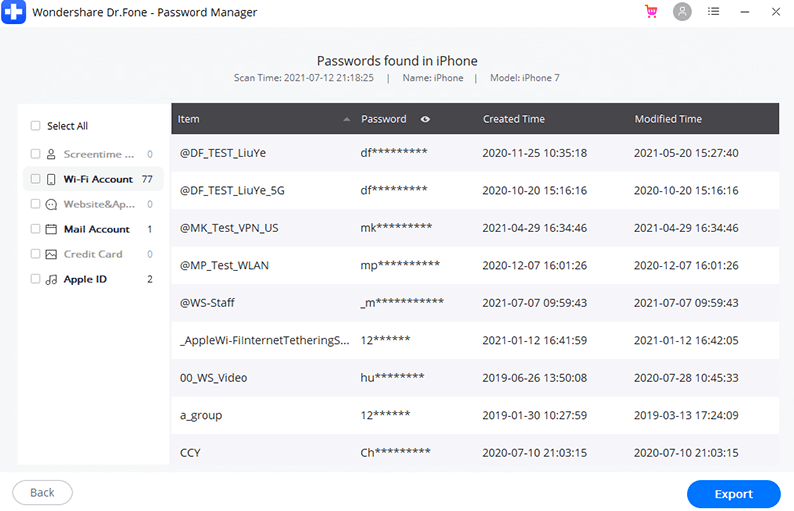
Android:
1Password
If you want to manage all your passwords in one app, then 1Password is your go-to app. It is available on Android as well as iOS. This app has several features apart from password management like password generation, cross-platform support on different operating systems, etc.
You can use the basic version of 1Password for free, or you can upgrade to premium version.
Final Thoughts:
Password managers are very common today on every device and browsers that you use. These password managers are generally linked with an account and synced on every device that you use.
Hopefully, this article helped you view your passwords and understand the process of how they are stored on devices. Apart from that, I also mentioned a Dr.Fone who can be your savior on certain occasions.
If you think I missed any method that can help view the passwords, mention them in the comment section.

James Davis
staff Editor
Generally rated4.5(105participated)